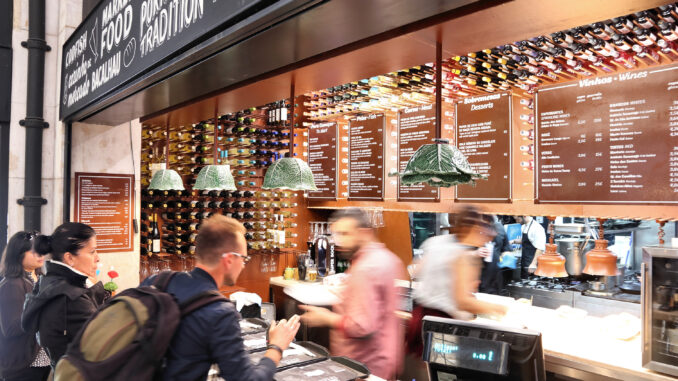
By Francine L. Shaw, Co-founder, My Food Source - 9.14.2023
In this era of technological advancements, the Internet of Things (IoT) has emerged as a game-changer across various industries, including food service. For restaurants, IoT is proving to be a crucial tool that drives efficiency, enhances food safety, mitigates risks, and boosts transparency across the supply chain.
There are many reasons that restaurants should embrace IoT and leverage its potential to maximize growth and streamline operations. The benefits of leveraging IoT in your restaurant include:
- Maximizing efficiency through data-driven insights. One of the most significant advantages of IoT in the restaurant industry is the ability to gather and analyze real-time data to optimize operations. Restaurant managers can use these insights to make more informed decisions to grow their business, save money, make strategic staffing and purchasing decisions, and more. Managers can access IoT-powered devices to monitor customer numbers, peak periods, and average orders. Using a smartphone app makes this information easily accessible from anywhere, empowering managers to make informed decisions in scheduling staff, marketing their business, and even augmenting their menu offerings to meet consumer demand. By leveraging IoT analytics, restaurant brands can boost productivity, improve resource allocation, and respond proactively to changes in customer preferences.
- Improving food safety. Connected sensors and devices allow real-time tracking and monitoring of food products throughout the supply chain. By leveraging IoT, restaurants can continuously monitor crucial variables like temperature and humidity to ensure optimal storage conditions. This proactive approach significantly reduces the risk of spoilage and contamination, allowing restaurants to serve safe, high-quality food to guests.
- Enhancing customer experiences through hyper-personalization. By collecting and analyzing customer data, including preferences, allergies, and dietary restrictions, restaurants can hyper-personalize their offerings to meet guests’ individual needs and expectations. Automated IoT systems can remind chefs of individual customer preferences and restrictions, enabling staff to serve personalized, safe dishes. This enhances customer satisfaction and confidence, helps build long-term loyalty, and encourages repeat business. With IoT-powered customer relationship management (CRM) solutions, restaurants can nurture personalized relationships, improve customer retention, increase positive reviews and recommendations, and drive revenue growth.
- Elevating communications and process monitoring. IoT facilitates seamless communication and enhanced monitoring in food service operations. Restaurants can ensure efficient communication by connecting various devices and systems, such as kitchen equipment, inventory management tools, and order processing systems. Smartphone-enabled monitoring systems allow managers to remotely oversee critical operations, identify bottlenecks, and address issues promptly. Real-time alerts can be sent to staff, ensuring timely response to food safety incidents and equipment malfunctions. With improved communication and monitoring through IoT, businesses can minimize downtime, prevent food safety breaches, minimize food wastage, and maintain consistently high quality standards.
- Boosting on-demand delivery and providing smarter logistics. IoT plays a significant role in transforming food delivery services. By integrating IoT-enabled devices into delivery vehicles, businesses can track the location, temperature, and condition of food throughout the delivery process. This ensures the freshness and safety of perishable items and enables businesses to provide real-time updates to their customers (including restaurants). Furthermore, IoT-powered route optimization algorithms can enhance delivery efficiency, reducing costs and improving customer satisfaction. With on-demand delivery capabilities driven by IoT, food businesses can serve a wider customer base, capitalize on the growing trend of online food orders, and stay ahead of the competition.
- Optimizing stock management and inventory tracking. Effective stock management is crucial for restaurants and other food businesses, allowing them to avoid food wastage and ensure uninterrupted operations. IoT offers real-time monitoring of inventory levels, expiration dates, and consumption patterns. Restaurants can automate stock management processes using connected sensors and smart shelves and receive alerts when supplies run low. This enables proactive procurement, minimizes stockouts, and reduces food wastage. IoT-powered inventory management systems can streamline the ordering process by automating purchase orders based on predefined thresholds. Efficient inventory tracking facilitated by IoT technology ensures optimal stock levels, reduces costs, and improves overall efficiency.
It’s clear that IoT is valuable for restaurants and other food businesses. Here are some tips to incorporate IoT in your organization:
- Start with a clear strategy. Define specific objectives and key performance indicators (KPIs) that align with your business goals before implementing IoT solutions.
- Invest in scalable infrastructure. Plan for future growth by choosing IoT devices and systems that can accommodate expanding operations and evolving needs.
- Prioritize data security. Ensure IoT devices and networks have robust security measures to protect sensitive customer data and prevent breaches.
- Ensure proper integration and compatibility. Select IoT solutions that seamlessly integrate with existing infrastructure and software systems to avoid operational disruptions.
- Prioritize continuous improvement. Regularly evaluate and update your IoT implementation to leverage new technologies, address emerging challenges, and stay ahead in a rapidly evolving industry.
- Train your staff. Some of your employees might embrace the latest technologies and others might be a bit more cautious. Educate all staff about the many benefits of IoT and explain how these solutions will elevate safety, efficiency, sustainability, transparency, etc. Show employees how the solutions work and be certain they’re comfortable using them.
IoT is revolutionizing the food service industry by driving efficiency, enhancing customer experiences, and optimizing operations throughout the supply chain. By leveraging IoT, restaurants can harness the power of real-time data insights, deliver hyper-personalized experiences, streamline communications, improve delivery logistics, and optimize stock management. By embracing IoT-powered solutions, restaurants can successfully implement and leverage this innovative technology, ultimately enhancing their competitive edge, driving business growth, and meeting the evolving expectations of today’s discerning consumers.
 Francine L. Shaw, food safety specialist, podcaster, and co-founder of My Food Source, is a successful entrepreneur, author, and speaker who spent 20+ years working in the foodservice industry. Her career has included performing services (operating partner, corporate/private trainer, health inspector, 3rd party inspector, adjunct professor) in various sectors of the foodservice industry. She has written hundreds of articles for national trade magazines and appeared on Dr. Oz, the BBC World Series Radio, and iHeart Radio as a food safety expert.
Francine L. Shaw, food safety specialist, podcaster, and co-founder of My Food Source, is a successful entrepreneur, author, and speaker who spent 20+ years working in the foodservice industry. Her career has included performing services (operating partner, corporate/private trainer, health inspector, 3rd party inspector, adjunct professor) in various sectors of the foodservice industry. She has written hundreds of articles for national trade magazines and appeared on Dr. Oz, the BBC World Series Radio, and iHeart Radio as a food safety expert.
Are you an industry thought leader with a point of view on restaurant technology that you would like to share with our readers? If so, we invite you to review our editorial guidelines and submit your article for publishing consideration.

